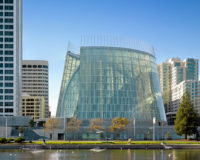Fifty years ago, in the 75th-anniversary issue of RECORD, editor in chief Emerson Goble addressed an issue he was constantly asked about—why the magazine wasn’t as critical as it had been in its early years. “We are charged with not having the nerve,” he wrote in July 1966. Before giving his reasons, let’s look at the magazine’s beginnings, when its critics would “give ’em hell,” as Goble put it.
When RECORD was founded in 1891, it aimed for a general audience as well as a professional one. Its critics Montgomery Schuyler, a newspaper journalist, and Russell Sturgis, an architect and historian, straightforwardly assessed the pluses and minuses of a building or urban enclave, according to aesthetic and, to a degree, functional criteria. Schuyler castigated heavy-handed eclecticism—what he called “artchitecture”—with its mishmash of styles. He considered proportion and scale, as well as how the program and structure were expressed on a building’s exterior. Sturgis’s more traditional aesthetic emphasized a Ruskinian predilection for the play of light and shadow—“the doctrine of the beauty of the penumbra,” as he called it. Yet Sturgis also welcomed the functional expression of structure in new buildings going up in the 1890s. He approved the steel-framed “rationalism” of the Bayard Building in New York by Louis Sullivan (with Lyndon Smith) but regarded the brick arches under the cornice as an “anomaly” (July–September 1898).
Both Schuyler and Sturgis tended to critique a building by scrutinizing the facade as if it were a two-dimensional composition they were viewing while standing on the sidewalk in front. When Schuyler also wrote about the Bayard Building, he barely discussed the interiors, nor did he mention the plainer sides of the 13-story high-rise (January–March 1899). He commended the terra-cotta on the main facade, which revealed the skeleton, and pointed to the way the different parts of the program—lobby in the base, offices in the shaft, mechanical services under the cornice—were signified in the design.
Sturgis’s negative critique of Frank Lloyd Wright’s Larkin building in Buffalo stands out as an aesthetic diatribe (April 1908). He also relied on a compositional reading, using only photographs, since he, an aging critic, was too sick to visit Buffalo. Wright’s innovative skylit interior needed to be experienced in person: its architectonic play of mass, void, and space was never described by Sturgis. At least RECORD published interior photographs in the critique and Wright’s own extensive presentation of his philosophy and work a month earlier.
While some architectural journalists traveled in those days—to Chicago to visit the World’s Columbian Exposition in 1893 and see the latest skyscrapers there—RECORD writers stayed close to their New York base. The metropolis was undergoing a major transformation, and, as tall buildings zoomed up, the critic’s viewpoint changed: he or she could examine them from afar, mid-distance, or close up, as did Schuyler in writing about the Woolworth Building (February 1913). He commended its design, by Cass Gilbert, for the Gothic-style vocabulary in which crenellations and gargoyles gave the 792-foot-high tower a sense of scale in relationship to the entirety and to the human body.
During that time, “Architectural Aberrations,” unsigned denunciations of eclectically styled structures, spiced up the magazine’s pages. A scholarly analysis later attributed the 26 essays to Schuyler, based on writing style. About the 12-story Cairo apartment house in Washington, Schuyler wrote anonymously, “The building is a box, and the combined owner and architect has done nothing to mitigate its boxiness. Upon the whole, we decidedly prefer the side, where he has not pretended to do any architecture, to the front, where he has made his unsuccessful pretensions in that direction” (March–June 1895). The last “Aberrations” was published in April 1912, and critiques in general became rarer as RECORD turned more and more to straight reportage of design, history, and techniques.
Although Sturgis called the Larkin Building “ugly,” RECORD early on devoted several articles (in addition to the extensive presentation in March 1908) to Wright’s revolutionary sense of space and his blurring of the boundaries between inside and out. This kind of exploration of modernist principles continued during the next few decades, complemented by its increasing coverage of European architects’ open-plan and functional precepts. Editorial pages brought increased attention to spare, unornamented, efficient design defined by improvements in materials such as concrete, steel, and glass. In the 1930's, under the influence of managing editor Lawrence Kocher, RECORD increasingly published expository articles on new building techniques, modular housing, and community planning (for more details about the architect and editor Kocher, see April 2016).
In those years, criticism did not stop, but the strong pro and con assessments were harder to find. As Goble would later point out in his July 1966 essay, the growth of the advertising base in the early 20th century, which valued circulation figures among practicing architects, spurred a shift from the lay audience to a professional one. Goble argued that RECORD benefited from the increased use of photographs, plans, and sections rather than the “more limited ideas of criticism.” In another essay in that anniversary issue, he contended that the selection of projects was a better form of criticism than the “fireworks of really negative attack.” Editors exercised critical judgment in their selection: “Every building that is published—good, bad, or indifferent—involves some element of criticism.”
Mildred Schmertz, editor in chief of RECORD from 1985 to 1990 (and on the staff for 33 years), wrote an article for Harvard Design Magazine in 1996 explaining why RECORD avoided those critical fireworks. “There was so much competition among architectural magazines to be the first to publish a ‘high-profile’ project,” that “the architect will pick the magazine he wishes the work to appear in and withhold the graphics [plans and sections] from the competing media.” During most of Schmertz’s years with RECORD, there were four architecture magazines, each with its own identity: Architectural Forum, which was known for its urbanistic hew; Progressive Architecture, which forged a strong reputation for publishing avant-garde design; The AIA Journal, which featured education and practice articles as well as pieces about other topical concerns; and then RECORD, known best for a thoroughgoing coverage of state-of-the-art design and technical matters.
In spite of a certain reluctance to antagonize architects, RECORD still welcomed screeds from the outside world. The famed public intellectual and architecture critic for the New Yorker, Lewis Mumford, brought a new kind of evaluation to RECORD in midcentury. Instead of just looking at a building as a composition, he placed architecture within the larger context of regional and city planning, urban design, and housing. In a series, “The Future of the City,” published in installments in 1962 and 1963, Mumford lambasted architects for creating taller and taller buildings and increasingly referred to the city as “an amorphous, overmechanized, urbanoid mass, lacking both esthetic identity and social character” (November 1962).
Mumford advocated strong urban planning—but not the sort propounded by Jane Jacobs, a former editor at Architectural Forum, who published the supremely influential book The Death and Life of Great American Cities in 1962. Mumford berated her for having a “pathological aversion to good urban design” (October 1962). “In order to avoid officious municipal demolition and regulation, she would return to Victorian laissez faire; in order to overcome regimentation, she would invite chaos,” he wrote. “She lacks an image of the modern city.” RECORD went on to commission more articles with a polemical tone. In December 1972, Michael Sorkin, who had just received his M.Arch. from M.I.T., wrote an essay, “Radical Alternative,” on the concerns of his generation: “A thoroughly radical position takes issue not with the form of the object . . . but with the process that generated the decision to make and use it.” Practitioners should be interested in “process not product,” Sorkin emphasized.
If RECORD was still reluctant to criticize architects who might get angry and withhold drawings in the future, it nevertheless gave Sorkin a platform in September 1986 to take apart the recent work of Philip Johnson and his partner John Burgee. Writing on the Crescent, a mixed-use development in Dallas, Sorkin demonstrated a pithy irreverence toward Johnson’s modus operandi: “No need to undergird formal enthusiasm with theory or relevance, to struggle for elaboration: the historic grab bag yields images for any occasion, an endless series of snapshots, history without memory.” Sorkin’s criteria for judging architecture, like Mumford’s, involved an urbanist viewpoint, if with a more subversive tone. Compared to the theory rife in the pages of academic architectural journals during these years, where key concepts such as semiotics, structuralism, and deconstruction were bruited about, Sorkin’s language was always lively and lucid.
Sorkin’s essays still appear in RECORD. At one point, Robert Ivy, the editor in chief from 1997 to 2010, assigned alternating monthly columns to him and to Robert Campbell of The Boston Globe. Other critics, such as Sarah Williams Goldhagen, have been enlisted to write under the current editorship of Cathleen McGuigan.
Last year, RECORD gave space to a spirited debate between Sorkin and Blair Kamin of The Chicago Tribune on a controversial proposal to build the Lucas Museum of Narrative Art on a prominent lakefront site in Chicago. When Beijing-based MAD Architects proposed a white, undulating scheme for the museum, Sorkin praised it for being “evocative of the light, simple, tensile structures of a Frei Otto tent” (January 2015). Kamin shot back in an essay in the next issue, including Sorkin in the group of Lucas museum proponents who “want to party like the recession never hit. Superrich clients! Icons! The Bilbao effect!” (The irony of including Sorkin in the crowd he so long impugned was not lost on certain readers.) Kamin hated the scheme for its misplacement on an “overburdened stretch of lakefront . . . fouling it with new levels of crowding and congestion.”
The Lucas Museum has now folded its tent and left Chicago, but the debate was healthy, no matter which side you took. While the architecture community may wonder if criticism is disappearing (along with print magazines and newspapers), there are, fortunately, strong and informed voices today, on paper and online. And the critical discussion can only be good for the profession and the public.















Post a comment to this article
Report Abusive Comment